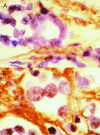Her-2/neu oncogene amplification in clinically localised prostate cancer
- PMID: 11865006
- PMCID: PMC1769579
- DOI: 10.1136/jcp.55.2.118
Her-2/neu oncogene amplification in clinically localised prostate cancer
Abstract
Aim: To examine the incidence of Her-2/neu oncogene amplification in clinically localised prostate cancer using in situ hybridisation.
Methods: One hundred and seventeen patients, who had undergone radical prostatectomy, were identified and in situ hybridisation was performed on formalin fixed, paraffin wax embedded tissue using the Quantum Appligene probe for Her-2/neu. The enzyme peroxidase was used to detect the probe because this enabled a permanent record to be kept. Tumours in which there were five or more signals in each nucleus in > 20% of the tumour cells were considered to have a significantly increased copy number. A serial section from these tumours was then hybridised with the chromosome 17 alpha satellite probe. The ratio of the percentage of cells showing an increase in Her-2/neu copy number to the number showing polysomy for chromosome 17 was calculated. A ratio above 2 was considered amplified.
Results: Biochemical recurrence occurred in 50 (43%) patients and 24 (21%) had clinical recurrence. In situ hybridisation for Her-2/neu was accessible in 114 (97%) patients. A significant increase in copy number was present in two patients (1.75 %), but chromosome 17 hybridisation showed that the increase was the result of polysomy rather than true amplification. Both these patients had a Gleason score of 7 and stage T3; they also had recurrent clinical disease with distal metastasis within two and 19 months.
Conclusions: Increased Her-2/neu oncogene copy number appears to be rare in clinically localised prostatic adenocarcinoma and is related to chromosome 17 polysomy rather than true amplification. As a result, it would not be a useful biomarker for identifying those patients who will have recurrences after radical prostatectomy.
Figures

References
-
- Ross JS, Nazeer T, Church K, et al. Contribution of Her-2/neu oncogene expression to tumour grade and DNA content analysis in the prediction of prostatic carcinoma metastasis. Cancer 1993;72:3020–8. - PubMed
-
- Zhau HE, Wan DS, Zhou J, et al. Expression of c-erB-2/neu proto-oncogene in human prostatic cancer tissues and cell lines. Mol Carcinog 1992;5:320–7. - PubMed
-
- Kuhn EJ, Kurnot RA, Sesterhenn IA, et al. Expression of the c-erbB-2 (Her-2/neu) oncoprotein in human prostatic carcinoma. J Urol 1993;150:1427–33. - PubMed
-
- Ross JS, Sheehan CE, Hayner-Buchan AM, et al. Prognostic significance of Her-2/neu gene amplification status by fluorescence in situ hybridization of prostate carcinoma. Cancer 1997;79:2162–70. - PubMed
Publication types
MeSH terms
LinkOut - more resources
Full Text Sources
Other Literature Sources
Medical
Research Materials
Miscellaneous
